As Part of Dia De Los Muertos, Families Go to the Panteon to
Contrary to pop conventionalities, the Day of the Expressionless fiesta, or Día de Muertos, is a celebration of life. Surprised? Don't worry! You'll leave here completely enlightened, knowingeverythingyou'll need to know to celebrate Twenty-four hour period of the Dead like a local…starting with: what is information technology exactly?
The three-twenty-four hour period festivity, starting October 31 and finishing Nov ii, is a popular Mexican holiday that celebrates the reunion of dead relatives with their friends and families. The fiesta is believed to assist the souls of loved ones on their spiritual journeying to the afterlife.
One of the nearly prominent traditions involves edifice altars chosen ofrendas in honor of the deceased. Families will visit the graves of loved ones – tidying and decorating sites with candles, trinkets, zempasuchil (marigolds; the flowers of the expressionless) colourfully painted skeletons, and the deceased'due south favourite candies and beverages, including atole and mezcal.
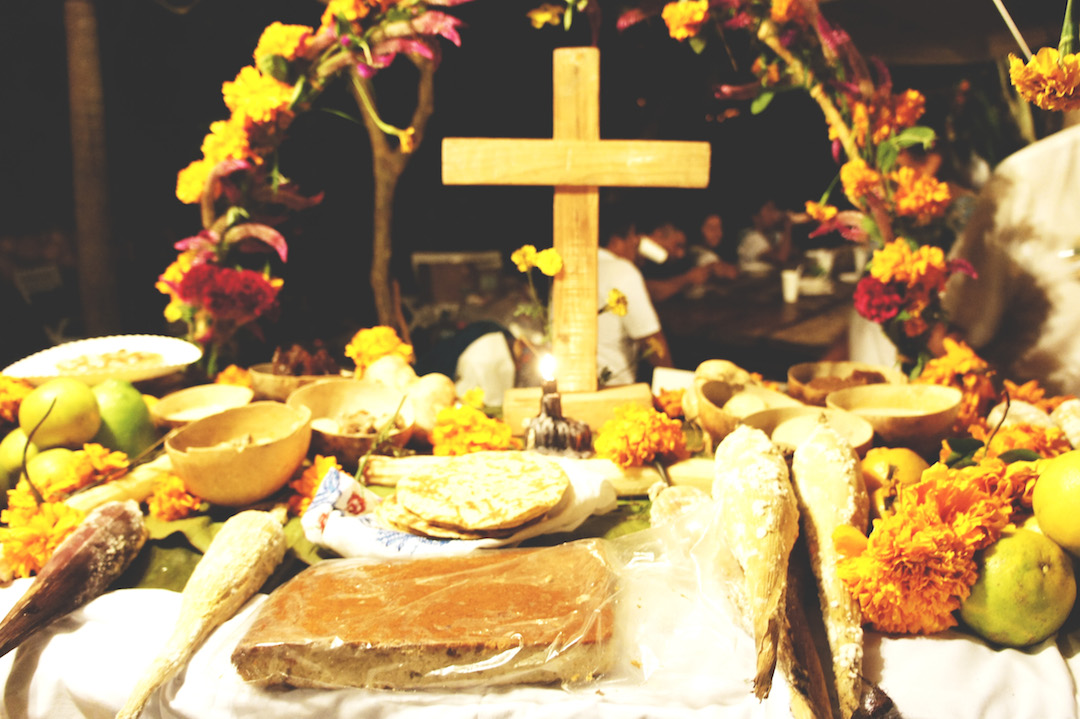
This may all seem slightly morbid to those non familiar with Mexican culture. Only it is quite the contrary, as Mexicans believe in the life-expiry-rebirth continuum; that death is part of the circular nature of life; it is not something to be feared, but rather acknowledged and celebrated.
La Calavera Catrina or the 'Elegant Skull' is an iconic image thought to embody the spirit of Día de Muertos. Dating back to the 1910's, this zinc etching of a female skeleton donning a feathered hat, was sketched by Mexican artist José Guadalupe Posada. The image, thought to symbolise the contrasting upper and lower classes, has gone on to inspire interpretations by many Mexican artists since, including Diego Rivera.
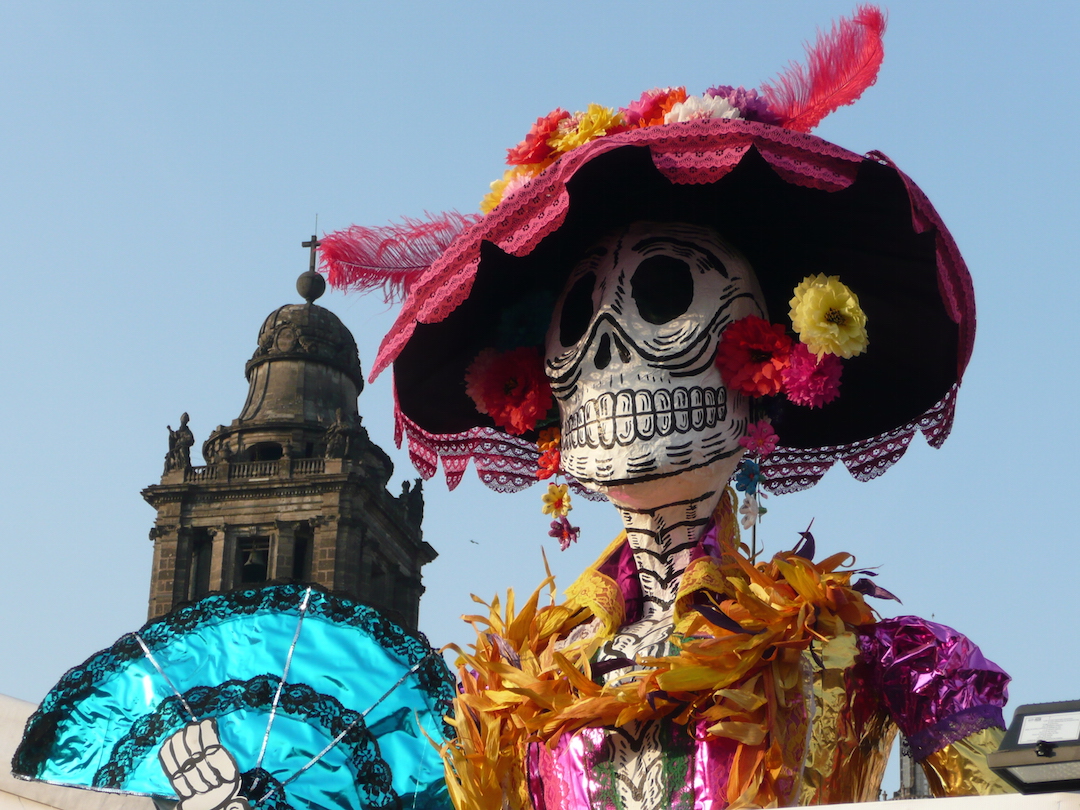
And so where did it all begin?
Day of the Dead celebrations date back to pre-Hispanic times and rose from the ancient traditions of pre-Columbian cultures some 2,500 years ago.
Prior to Castilian colonization in the 16th century, the celebration took place at the beginning of summer for an entire month. The aboriginal indigenous peoples of United mexican states (Purepecha, Nahua, Totonac and Otomi) believed that the souls of the dead return each year to visit with their living relatives – to eat, drinkable and be merry, replicating what they did when they were living.
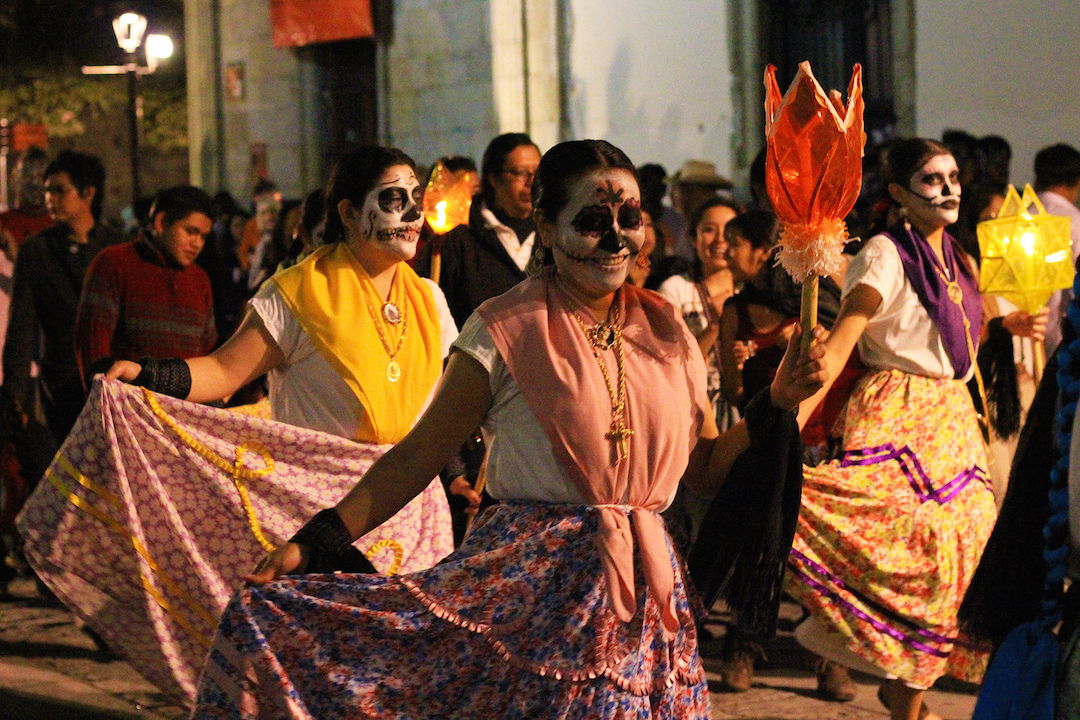
The festival now takes place October 31, November 1 and November 2, idea to coincide with Christian traditions of All Hallows Eve, All Saints' Day, and All Souls' Day.
On October 31st (All Hallows Eve), children make altars to invite the spirits of expressionless children, angelitos, to come dorsum and visit. November 1st, (All Saints Twenty-four hour period) is dedicated to the celebration and visitation of the adult spirits, and November 2 (All Souls Day) is when families visit the cemetery to tidy and decorate the tombs of their relatives. It is idea that when children take part in Día de Muertos and trip the light fantastic with caricatures of death, that they learn to respect the fleeting nature of life. On these nights, ane can discover rows of food stalls and carnival attractions outside many local cemeteries, keeping the festivities alive well into the night.
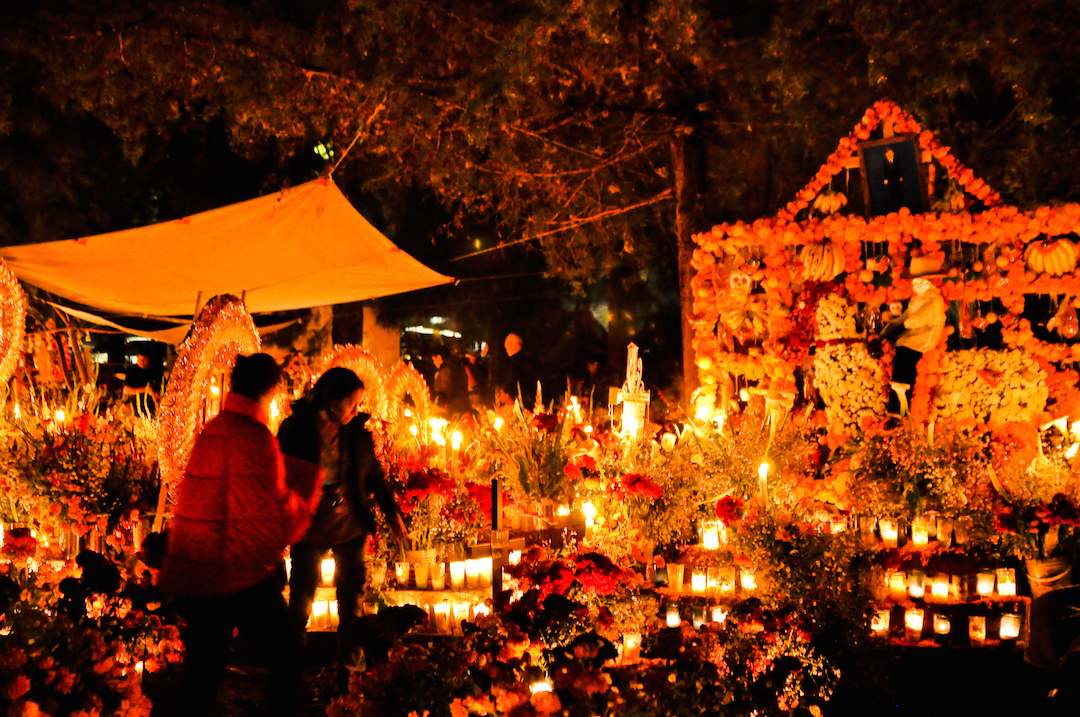
Although the holiday is historic all over Mexico, most notably in the south and key regions, traditions are not universal and ofttimes vary from town to town.
In Ocotepec, in the State of Morelos, families open up their doors to visitors in exchange for veladoras (pocket-sized wax candles) – a sign of respect for the recently deceased members of the family.
The state of Michoacán is likewise another popular destination for travellers during Día de Muertos commemoration. Festivities in the country's rural areas cumulate in local cemeteries inundation with colour. Indigenous communities decorate the grounds with flowers, candles and carbohydrate skulls.
Where should you celebrate?
Mexico Urban center: Zócalo public square
What happens hither?
Festivities include a parade of people dressed every bit female skeletons and street parties that last all night long. If you hang about long enough, you lot might come across a Alebrijes – bright and colourful folk art sculptures of fantastical creatures. The square is usually host to an annual altar contest – which means you lot'll become to see your share of extravagant altars.
Notable mentions: The Diego Rivera Museum and the Culture Museum in Coyoacan are host to some impressive altars. Major vigils are held in some of the metropolis'southward largest cemeteries including Bosque de Chapultepec and Panteón Civil de Dolores.
Mexico City: Mixquic & Xochimilco
What happens here?
Mixquic is located southwest of United mexican states city – and so if y'all want to venture a piffling out of the urban center eye, this is the spot for yous. Stalls line the streets during the days leading upwards to the festivals and come night time, y'all'll grab a glimpse of a procession deeply rooted in local indigenous conventionalities. A cardboard coffin winds it way through the town and leads townsfolk to the boondocks cemetery for a candlelight acuity.
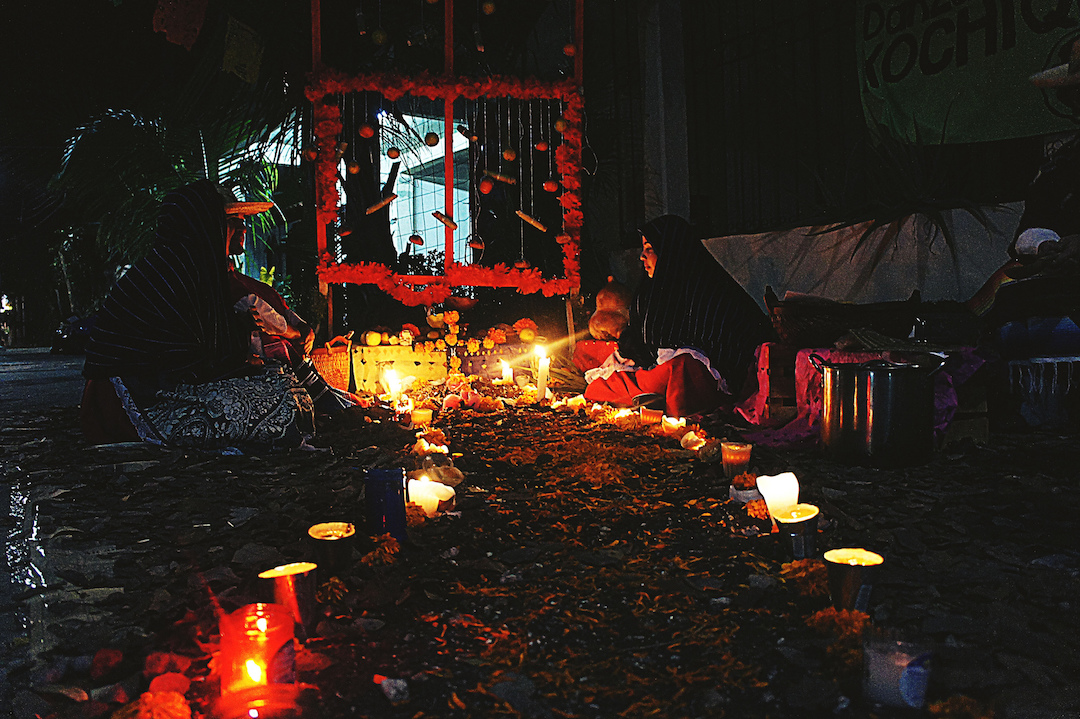
Xochimilco, just south of Mexico Metropolis, is a mystical flowing adventure come 24-hour interval of the Dead. Hop aboard a trajineras , a brightly painted covered boat (similar to a gondola), and bladder through the town's network of canals, winding through chinampas (floating island gardens). It is here that you tin catch a performance of the Legend of La Llorona or "the crying mother." Every bit legend goes, there was a mother who drowned her children and became then guilt- ridden past her actions that she committed suicide. Ever since and so, her spirit tin can exist seen on the canals of Xochimilco, crying: "ay, mis hijos…" or "Oh, my children!" in English.
Oaxaca: Oaxaca City
What happens here?
You'll witness a very special Oaxacan tradition, the creation of sand tapestries. After the burying of a family fellow member, a sand tapestry is made in the home of the deceased depicting diverse religious images. Afterwards nine days of praying, the tapestry is swept upwardly and the sand is collected and poured onto the gave. During Día de Muertos y'all volition see many of these tapestries along the streets, in public buildings and shops.
Notable mentions: Visit the local markets in and around festival time for a taste of the action. Which ones are worth your time?
- The 20 de Noviembre Market or the Central de Abastos Market just south of the city center
- Friday market in Ocotlan – famous for its 'nieves' (water ice foam)
- If cemeteries are more your affair, Panteon General, also known as the Panteon San Miguel and Panteón Nuevo, will offer a colourful feast for your eyes of beautifully decorated altars and candles that light upwardly the night sky.
Michoacan: Janitzio and Patzcuaro
What happens here?
Known as the unmarried best-known location for Day of the Dead in the entire state, you'll accept an opportunity to encounter the indigenous Purepecha people perform elaborate Día de Muertos rituals in the boondocks cemetery well into the night. The coolest part? Town and local fishermen in their rowboats illuminate the nighttime sky with torches.
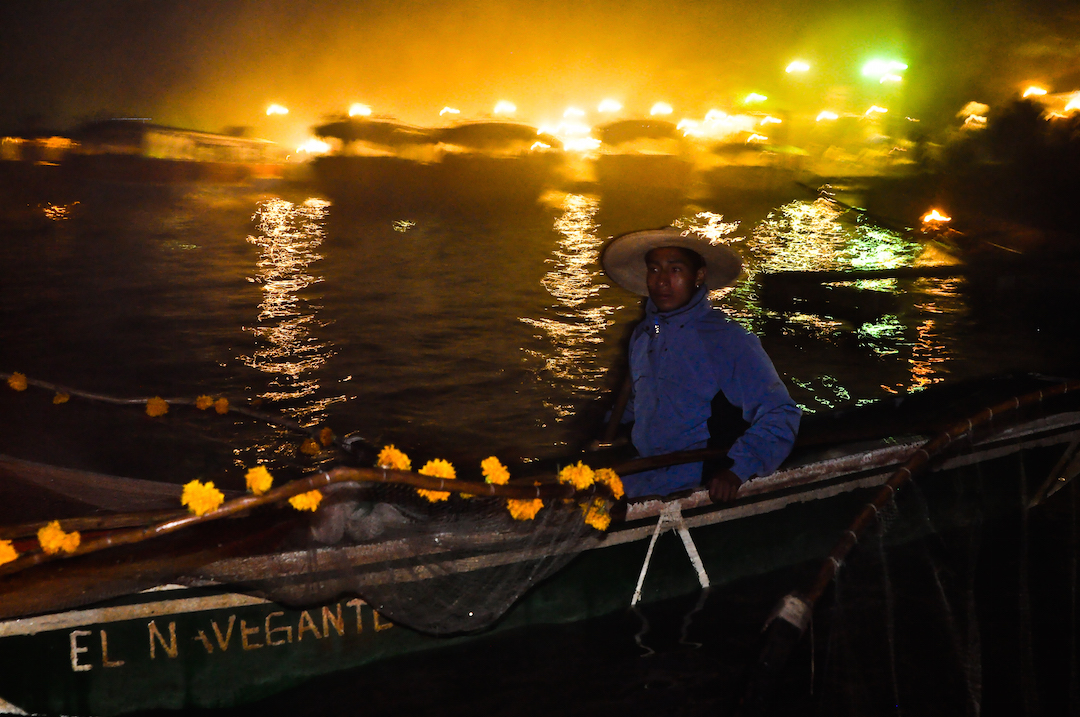
Aguascalientes: Aguascalientes Urban center
What happens here?
Aguascalientes is the birthplace Jose Guadalupe Posada, the printmaker, and cartoonist who created La Calavera Catrina, the skeleton in the feathered hat synonymous Twenty-four hours of the Dead. It has in most contempo times get the place to exist for Día de Muertos, with over 200 events lined up during the festival, including a parade in honour of Posada iconic image. It is also home to the Museo Nacional de la Muerte (National Museum of Death), which houses an all-encompassing drove of Day of the Dead artifacts and historical pieces.
Additional tips…
In order to ensure that your trip to United mexican states to feel Dia de los Muertos is hiccup-free, brand sure you note these essential tips and tricks:
- Book accommodations early, hotels and hostels fill upwards quickly
- Ask permission before taking photos in the cemeteries
- Do non travel with non-authorized taxis
- Get in the spirit by donning a traditional Mexican Day of the Dead costume and/or makeup
- When visiting cemeteries, be respectful of the families honouring the dead
- Plan extra fourth dimension before or after the celebration to explore Mexico
Getting the "Day of the Dead" Look Right, Co-ordinate to a Real Makeup Artist:
Makeup artist and blogger Jen Vanderzalm offers her tips on how to achieve the perfect Dias de Meurtos look to assist yous celebrate the festivities in style.
Getting started…
1. Starting time off, you'll want a clean moisturized face up and pilus pulled back and out of the way. Possibly a glass of wine too if yous're like me and love drinking while getting creative. Begin by covering your face up with your white makeup; you can use your fingers or a sponge to do then. Build it up if necessary and endeavor your best to go along it even looking by adding a second layer.
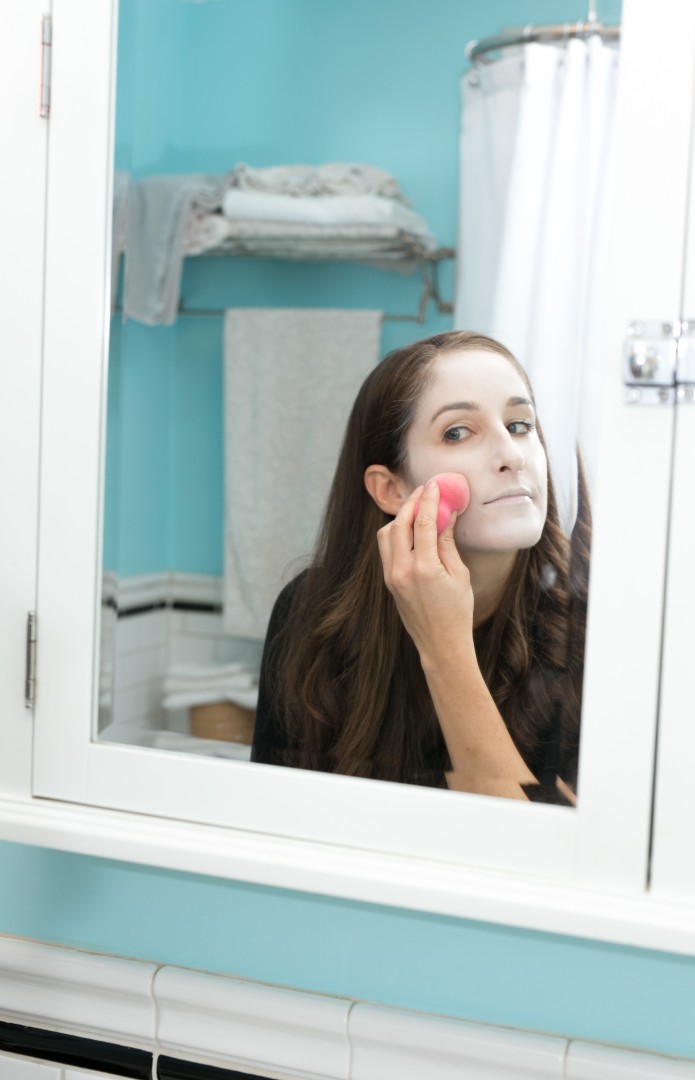
2.Take your blackness liner and draw a circle around your eye starting with the top of your countenance and following your socket all the way around until it joins back up.

3. Add together a pop of colour or you can continue it all blackness, information technology'south up to you!

4.Hither you will desire to alloy the colours together a bit better. If you make a error, this is where the q-tips volition get your best friend. But wipe away the error and merely re-employ more white.

five.The hardest part has arrived, but you can do it! Have your pointy skinny castor and depict on the scalloped edges (call back semi-circles) around both optics. Think those q-tips.

6.And now for the nose. I similar to draw the upside down heart, but it tin be every bit simple equally a triangle too. And so you lot just have to fill it in with pigment.

7.This is especially where waterproof makeup comes in handy. First by applying a straight line downward the middle of your oral fissure and piece of work your way out on both sides. These are meant to represent the teeth and then as yous become further, follow along with your actual jawline.

eight.This was my favorite part, connecting it all together. For this step, I recommend that you just follow forth with your cheekbone.

9.For my own forehead details, I chose an 'S' for my Grandmother's maiden proper noun Stewart. I miss her dearly and thought of her as I drew the designs in that location. I used black and purple eyeliners but feel costless to choose a design that represents who you volition exist honouring this Twenty-four hour period of the Dead.

10. Next, I embellished my chin with a fern-type flower on it. I also filled in the scalloped edges with imperial shadow. As a final touch, I wanted to use marigolds as they are a commonly used bloom during Mean solar day of the Expressionless but I couldn't find any, so I improvised with rose stems and secured them into my hair with bobby pins. Tada!

Required products: White confront pigment (or very pale foundation), b lack eye shadows or blackness face paint, b lack Eyeliner (the sharper and thinner or a bespeak, the meliorate), l ip or eye pencils in vibrant colours
Required tools: clean fingers or sponges, t iny brush for small-scale details, thousand edium shadow brush, q -tips
Extras: Jewels or sparkles, g litter glue, eyelash glue, k akeup setting spray (oestrus, humidity resistant), f alse lashes, f lowers
If you'd similar to cheque out any of my other Halloween looks please check out my Instagram, Facebook and website.
Thank you so much for reading about my Day of the Dead Saccharide Skull Makeup!
So what practise you think? Is this the year you get reacquainted with your deceased loved ones confronting Mexico'south beautiful backdrop? Tell us your favourite means to celebrate in the comments below!
Source: https://www.tourradar.com/days-to-come/everything-about-day-of-the-dead/
0 Response to "As Part of Dia De Los Muertos, Families Go to the Panteon to"
Post a Comment